
Large projects can easily become huge projects without the right budget management. While it can feel like the costs keep adding up and popping up out of nowhere, it can be difficult to know when to draw the line. Here are some of the best tips to cost-manage any large project to ensure you don’t end up with more bills than you anticipated.
Before we dive into the tips for managing your project, here are some of the factors that will affect the cost-management of a large project:
- Project costs
- Project budget
- Project cost estimates
- Project management software
- Know your project inside and out
Firstly you need to know your project inside and out. Without knowledge of exactly what the project will entail, it is impossible to be able to effectively manage costs. So before making any financial decisions, it’s crucial that you sit down with your team and work through every aspect of the project. This way you will be able to identify any areas of over expenditure, or even where costs may have been underestimated.
Most of the time when projects exceed their budgets or deadlines, the root of the problem often lies in poor planning. You can get ahead of any logistical or financial issues by doing an adequate amount of planning for your project.
Table of Contents
1. Hire professionals

img source: groupsourceinc.com
If you’re really serious about keeping the costs of your project down, then hiring a cost management company like could compass-pc.com be the way to go. Specializing in keeping costs down and only spending money on what really needs to be done, a cost management consultant can be the most effective way to keep costs down.
Why hire professionals?
They are an impartial, third-party player that will be able to see things objectively and not be swayed by stakeholders or clients. This means that you can get the fairest cost estimate that cuts down on costs where you really need to, rather than keeping in mind what particular parties want including in the project. A cost management company is a fair and reliable way to make sure that a large project stays within its budget.
Another reason to hire a cost management consultant is that they really do know what they’re talking about. You can benefit from the expertise of a consultant that your finance department simply won’t have access to, not to mention the network and contacts that a cost management firm will be able to use to your advantage.
2. Cut down on unnecessary costs

img source: moneycrashers.com
The larger the project, the more red tape and processes there will be. These can easily build up unnecessary costs and time-wasting practices. While it’s difficult to get around red tape and bureaucracy, you can cut costs when it comes to processes. Often you will find that a task gets split up into smaller subtasks that often simply aren’t needed, or work has to go through 3 or 4 stages of unnecessary reviews before it is green-lit.
Streamlining processes is one of the easiest ways to cut costs because when you do so, you can save your team’s time and the money that would have been wasted on wages. Cut out any unnecessary processes and steps in your workflow to maximize efficiency and save resources and time. An easy way to work out what can be streamlined is when you go through each stage or step of the project, ask yourself, “Is this essential to the project?”. If the answer is no, or there is an easier way to go about things, then you can implement changes and cut down on your steps.
Another source of unnecessary costs is your indirect costs. This can include overheads like office rent, utilities, insurance and equipment.
3. Choose the right people

img source: wrike.com
When putting your team together for a project, especially for large projects, you must make sure that your choice of personnel is right. When it comes to achieving optimum efficiency, you need to choose wisely. So be realistic with what you’re looking for in your team’s performance and delegate tasks and responsibilities accordingly.
The project must come first, meaning that social ties and to an extent, company hierarchy, cannot affect the makeup of the team. Choose members based on their skillset and characteristics, otherwise, the project will be slowed down. Here are a few examples of the types of people that are best suited to certain roles.
- Project manager. This role needs someone who is highly motivated, organized, confident and flexible. They may be needed to support on a range of issues, and also be comfortable with making decisions and taking responsibility for them. This needs to be someone who can wear many different hats and ultimately, deliver results.
- Construction and design. The team members covering the ‘doing’ side of the project will need to be highly organized and committed to their work, not to mention being good at what they do. While this goes for any job, the actual construction and design of your project need to be of an excellent standard to make the project a success.
- Surveyors. This role is very technical and needs someone with a good eye for detail and precision. They must be very knowledgeable about their craft and also be able to give real feedback to the team.
Of course, no one is perfect, so you need to be aware of your team’s strengths and weaknesses, and then play to said strengths but also make sure that any weaknesses are supported by others.
4. Budget realistically

img source: who.int
Whether you use the incremental or zero-based budgeting system to allocate costs across the project, you need to make sure that your budget is feasible and realistic. If you heavily underestimate the costs of your project, then a lot of costs will end up cropping up later on. In the same breath, overestimating the costs of the project will only end up costing you in the long run.
Overall, these tips can help you to keep your costs down and get the most value out of your project.







